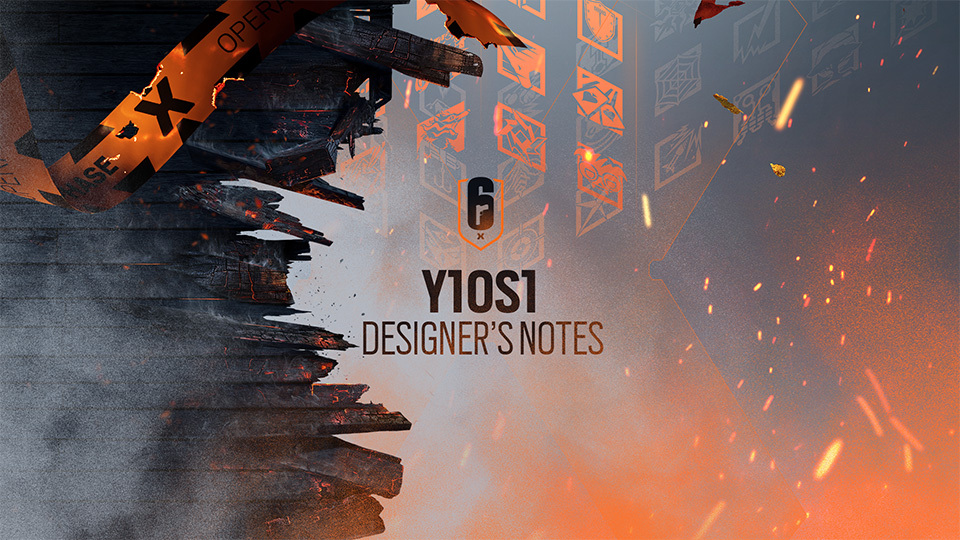2 months
ago -
UbiWayfarer
-
Direct link

In this latest edition of Designer’s Notes, we are sharing details on the balancing changes process and why we will not be pushing additional changes this season.
YEAR 10 SEASON 1
We have decided to let the game stabilize for a bit longer than usual in preparation for everything coming and start the new Siege era with more stable data overall. Every patch we release, even though we are building towards a fixed direction, adds more entropy into the mix, making it harder to evaluate the impact of every change. However, we wanted to take this opportunity to share some insights about our thought processes.
BALANCING PROCESS INSIGHTS
To begin with, in the context of strategy and tactics, the defensive team typically holds the advantage. It's like assaulting a fortress; expecting the attacking force to have equal chances of victory as the defending force is unrealistic. Defenders have the privilege of choosing the battlefield; they are essentially playing at home. In a game like Siege, defenders also alter the battlefield every round, while attackers have a mere 180 seconds to analyze and execute a new strategy based on the information gathered, which might only be reliable for a brief period. This is why we aim for a 55% defensive win rate with a 5% tolerance.
The different matrices represent the big picture of the game and help us interpret its current state. We have plenty of them: different ranks, platforms, playlists, and even specific ones per map. Observing an outlier value triggers a discussion, not an immediate action. During these discussions, we focus on the overall vision of the game more than on the outlier. Siege has many moving parts, and even small changes can have significant consequences, which may not become apparent immediately and can take months or even years to fully manifest. This is why we continuously evaluate both new and old changes, as their effects on the game can vary from patch to patch. It's also important to highlight that buffs and nerfs are often two sides of the same coin. Buffing one operator typically means others are indirectly nerfed. As the buffed operator becomes more appealing, others with similar roles become less interesting, which has a similar effect to nerfing them. In reverse, nerfing an operator means that others are indirectly buffed and more appealing to use.
When we see operators with very high presence, we see a reduction on variety. Playing and facing the same operators repeatedly can be boring and feel repetitive. Their ideal presence is around 13%, even though we don't aim strictly for this. If every operator were in their sweet spot data-wise, it would mean that everyone is viable in all situations, making operator selection feel meaningless. This is why we intend to make them situational, so the map, site, intel available, and team composition determine who is the best option. Every operator must be strong in the right situation but with flaws in the wrong one. On the other hand, operators with extremely low presence might be boring, not impactful enough, or simply not fitting into the current meta. And our approach is different depending on the reason.
Regarding win deltas, they mostly represent how the operator is performing in the current meta rather than their inherent strength. We cannot say that Maverick is too weak when he can bypass any wall denial without help, or that Kapkan is too strong when there is always an Ash rushing without droning, leaving attackers one operator down 20 seconds into the round.
COMMUNITY FEEDBACK
Additionally to the hard data retrieved from your in-game matches, our teams also analyze your feedback via different means in order to have the best understanding of the current meta and what you, as players, have to say.
There are two approaches to gather player feedback, one could be considered as indirect and the other as direct. For the former, the feedback is found through the comments you naturally share on social media or other platforms and generally touches broader topics. The latter, on the other hand, requires targeted investigations. The intel is then collected through workshops involving experienced players and community members, topic-specific surveys, and Seasonal surveys. Once gathered, the feedback data is then translated into digestible formats for a better understanding of the community concerns, thoughts and ideas.
We will never say this enough: your feedback matters and changes the game. Please keep on sharing your thoughts on our different social media platforms and our dedicated Seasonal Surveys.
Y9S4 RANK DISTRIBUTION

